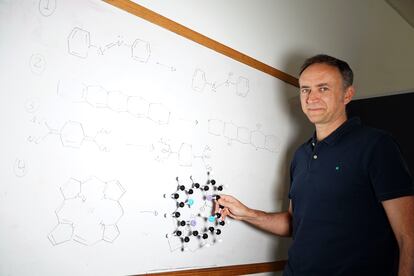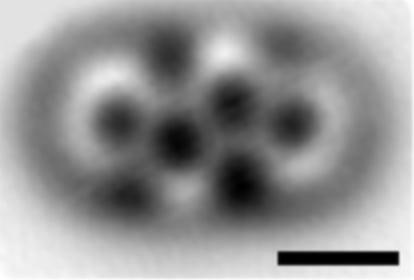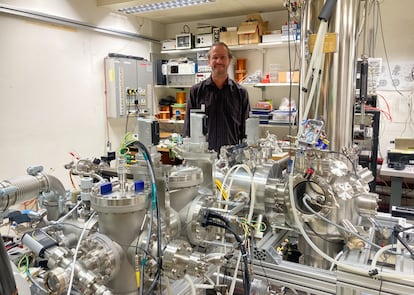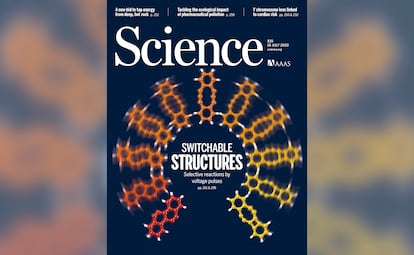For the first time in history, we can modify atomic bonds in a single molecule
The breakthrough will enable us to build futuristic molecular machines capable of performing tasks like the intelligent distribution of drugs

An international team of scientists has succeeded in modifying individual molecules by selectively forming and disassociating bonds between their atoms. The breakthrough will enable the creation of new molecules that were previously inconceivable, according to Spanish chemist Diego Peña, one of the leaders of the research team. “This technique is going to revolutionize chemistry,” he said. The study is featured on the cover of the prestigious Science magazine.
A molecule is simply a cluster of atoms. Water – famously known as H₂O – has two hydrogen atoms and one oxygen atom, joined by covalent bonds that share electrons. To modify molecules, scientists currently use a process manner likened to putting Lego blocks in a washing machine and hoping that the quintillions of molecules somehow end up assembling themselves into the desired product. This is the analogy used by Igor Alabugin and Chaowei Hu in another study published in Science. But Peña’s team instead used a state-of-the-art microscope, capable of focusing on a single molecule, one millionth of a millimeter in size, to selectively modify the molecule’s bonds using voltage pulses.
“We can now assemble atoms in previously inconceivable ways,” exults Peña, a professor with the Center for Research in Biological Chemistry and Molecular Materials (CiQUS), at the University of Santiago de Compostela in northwest Spain. Borrowing a famous line from the movie Blade Runner, Peña said, “I have seen molecules you wouldn’t believe.” The research team succeeded in creating different structures using 18 carbon and eight hydrogen atoms to form rings and other shapes, and then reverted them to the original structure. “If you were to ask chemists if some of these molecules could be synthesized, they would tell you it’s impossible, because the molecules would react with their environment and only last for a few milliseconds,” said Peña.

Peña’s team used an advanced version of the tunneling microscope invented by IBM scientists Gerd Binnig and Heinrich Rohrer, winners of the Nobel Prize for Physics in 1986. These instruments operate at cryogenic temperatures in an ultra-high vacuum to ensure molecular stability, and are capable of imaging surfaces at the atomic level. The Peña-led team was previously featured on the cover of Science magazine in 2012 when they were the first to distinguish individual molecular bonds.
Leo Gross, a German physicist with IBM’s research laboratory in Zurich, is one of the lead authors of the research study. “Selective single-molecule reactions may enable the creation of novel, more complex, and more versatile artificial molecular machines,” said Gross, who envisions a future with better drug synthesis and delivery. “These molecular machines could perform tasks such as transporting other molecules or nanoparticles, manufacturing and manipulating nanostructures, and facilitating chemical transformations,” said Gross. But to get there, this nascent technique must first be mastered.

Peña, Gross, and their colleagues used low-voltage electrical pulses to manipulate a molecule (composed of 18 carbon and eight hydrogen atoms - C₁₈H₈) and created three distinct three-dimensional structures. Using the same technique, the configuration of the molecule can be changed over and over again, hundreds of times, to see if the result will react with other molecules. In their Science article, Alabugin and Hu liken this technique to “a Swiss Army knife for surface chemistry.”
IBM’s Zurich Research Laboratory builds the sophisticated microscopes that scientists like Peña use to solve challenging chemistry problems such as analyzing molecules in meteorites. “Classical techniques needed several million molecules for detection. With this new technique, the detection threshold is now only a miniscule piece of a single molecule,” said Peña.

Chemists from the University of Santiago de Compostela and physicists from IBM have also researched the molecular structure of asphaltenes, solid components of petroleum that clog pipelines and are known as “the cholesterol of oil refineries.” When asphaltenes clump together to form a blockage, refinery operations must be halted so it can be removed. “We can analyze the structure of asphaltenes to help develop additives that prevent these molecules from clumping together in pipelines,” said Peña. His research consortium, which includes the University of Regensburg (Germany), received a $9 million grant from the European Research Council two years ago.
Diego Peña was in Madrid recently at the farewell concert of one of his favorite musical groups, Siniestro Total. Known for their irreverent lyrics that often take digs at science, the band from Galicia (northwest Spain) sang one of their anthems: “What is being? / What is essence? / What is nothingness? / What is eternity? / Are we soul? / Are we matter?” Peña mused on the matter that makes up human beings and everything else. “It’s very important for society to understand the value of basic research – it’s knowledge for knowledge’s sake. I want to be able to control how atoms are assembled. Why is that useful? Well, it’s useful for everything, because molecules and atoms make up everything.” The many applications of this science, such as creating new molecules, have yet to be envisioned. We’ll just have to wait and see, says Peña. “Obviously, we’re not going to cure cancer overnight.”
Tu suscripción se está usando en otro dispositivo
¿Quieres añadir otro usuario a tu suscripción?
Si continúas leyendo en este dispositivo, no se podrá leer en el otro.
FlechaTu suscripción se está usando en otro dispositivo y solo puedes acceder a EL PAÍS desde un dispositivo a la vez.
Si quieres compartir tu cuenta, cambia tu suscripción a la modalidad Premium, así podrás añadir otro usuario. Cada uno accederá con su propia cuenta de email, lo que os permitirá personalizar vuestra experiencia en EL PAÍS.
¿Tienes una suscripción de empresa? Accede aquí para contratar más cuentas.
En el caso de no saber quién está usando tu cuenta, te recomendamos cambiar tu contraseña aquí.
Si decides continuar compartiendo tu cuenta, este mensaje se mostrará en tu dispositivo y en el de la otra persona que está usando tu cuenta de forma indefinida, afectando a tu experiencia de lectura. Puedes consultar aquí los términos y condiciones de la suscripción digital.
More information
Últimas noticias
Aquilino Gonell, former Capitol sergeant: ‘If it hadn’t been for the police, the US would be a dictatorship’
A hybrid building: Soccer pitch, housing, and a shopping mall
Europe urges Trump to respect Greenland following annexation threats
Science seeks keys to human longevity in the genetic mixing of Brazilian supercentenarians
Most viewed
- Alain Aspect, Nobel laureate in physics: ‘Einstein was so smart that he would have had to recognize quantum entanglement’
- Mexico’s missing people crisis casts a shadow over World Cup venue
- Why oil has been at the center of Venezuela-US conflicts for decades
- Trump clarifies who is ultimately in charge in Venezuela: ‘Me’
- Mexico seeks to shore up its defenses following US incursion in Venezuela











































